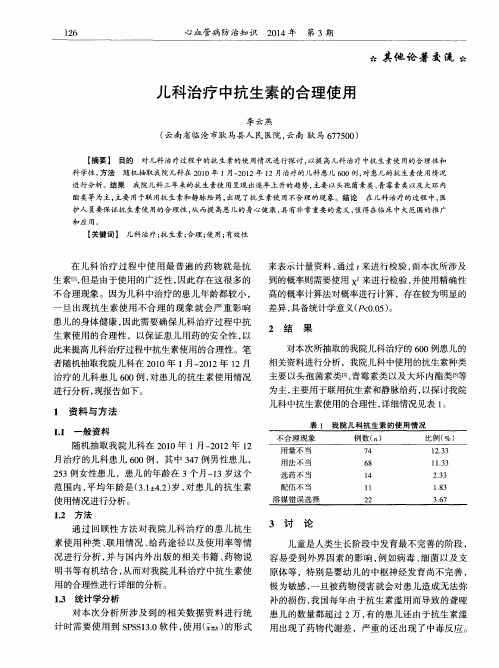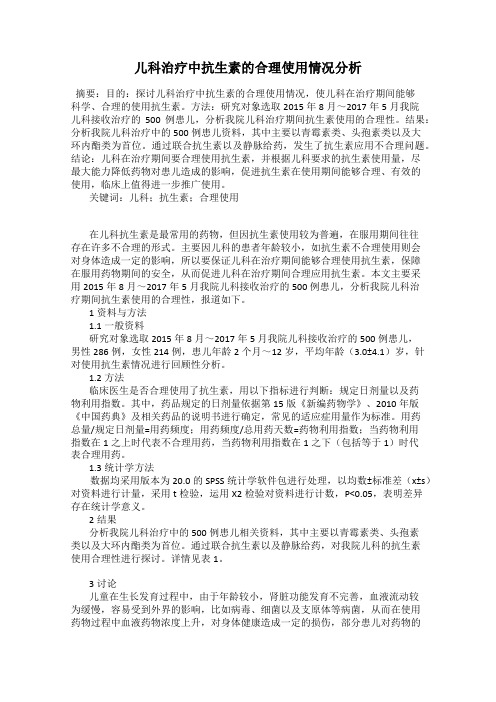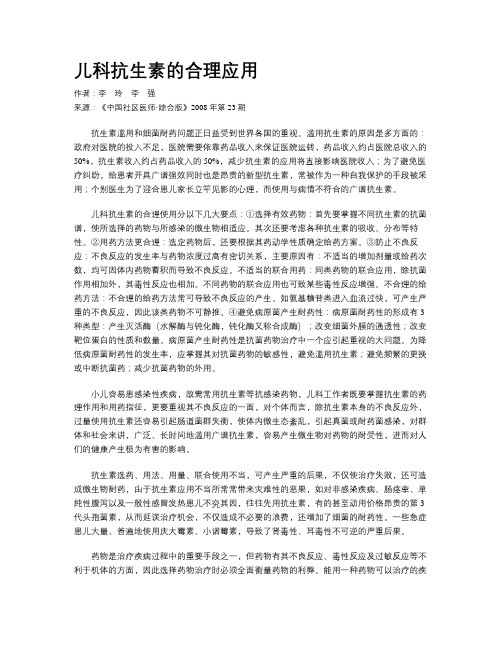我国儿科门诊抗生素的使用-王楚宁
儿科抗生素的合理应用及措施分析

每组各 3 9例 。对照组 中,男 2 1 例 ,女 1 8例 ;年龄 1~7岁 , 平均 ( 3 . 5± 0 . 9 )岁 ;病凶 :呼吸道感 染者 1 5例 ,泌 尿系统 感染 1 1 例 ,胃肠道感染 9例 ,其他感 染 4例。观察组 中,男 2 O例 ,女 1 9例 ;年龄 2~ 8岁 ,平均 ( 4 . 2±1 . 1 )岁 ;病 : 呼吸道感染者 1 6例 ,泌尿 系统感染 1 2例 ,胃肠 道感 染 8例 , 其他感染 3例 。两组一般资料具有可 比性 。 1 . 2 方法 对照组 :按照抗生素基本原则进行治疗。观察组 :
3 讨 论
治 的 应用 抗 生 素进 行 治 疗 的 患 儿 7 8例 ,分 成 对 照 组 和 观 察 组 ,
儿童正处 在生 理的生长期 ,且凶婴幼儿的肝 、肾等重要 器 官还没有发育成熟 ,其对抗 生素的消除能力相对较弱 ,很容易 导致诸多毒性反应 的发 生 ,又加之儿 童对 外界 的刺激具有较强 的反应 ,其适应力 差 ,抵抗力 弱 ,并且神 经系统没有得 到完善 的发育 ,因此更容 易受 到损 害 ,在临床治疗过程 中,若是抗生 素使用不合理 ,则会导致诸多系统 的毒性反应 。有不少患儿 由 于错杀体 内正常 的益生菌群 ,从而导致肠道菌群失调现象的 出 现 ,最终导致诸 多 肠道 功能异 常 等不 良反应 的发 抗生素使用方式进行治疗 的观察组患儿 的住院时间较对照组短 ,治愈率较对照组高 ,不 良反应 发生 率较对照组低 ,由此可知 ,正确合理规范使用抗 生
素能够有效 改善儿科疾病的治疗效果 ,降低并发症的发生 ,这
对于改善儿 童健康具有重要的临床意义 ,值得关注。
参 考文 献
1 张娟 . 儿科抗生 素临床 运用 中的合 理用药浅析 [ J ]. 亚太传 统医
儿科常用药物的使用

儿科常用药物的使用
一、抗生素类
1、青霉素类
青霉素类,是一类抗菌药物,可以有效抑制细菌的生长,能有效抑制多种细菌,具有较强的抗感染能力,是治疗小儿感染的常用药物,包括氨基酚羟青霉素、头孢菌素及其他衍生物等。
应用:用于治疗肺炎、肠炎、咽炎、膀胱炎、中耳炎、腮腺炎、咽喉炎等细菌感染,也可用于急性炎症和慢性炎症治疗。
注意事项:治疗前应严格遵医嘱确定相应疾病的病原,以防青霉素的过量使用。
2、头孢类
头孢类药物具有较强的细菌抑制和杀灭作用,可以杀死许多细菌,包括链球菌、支原体等,血清抗体水平低,可以有效抑制细菌的生长,常用的头孢菌素类药物有头孢硫脒、头孢曲松、头孢氨苄、头孢噻肟等。
应用:一般用于治疗小儿的呼吸道等感染性疾病,如肺炎、肺结核、中耳炎、咽喉炎等,也可用于治疗小儿慢性支气管炎。
注意事项:治疗前应确定感染病原,以防头孢类药物的不恰当使用。
3、磷酸氯喹类
磷酸氯喹类抗生素是一类新型抗生素,能有效抑制细菌多糖的合成,促使细菌凋亡,是当今小儿感染治疗常用的药物。
儿科临床抗生素的使用

儿科临床抗生素的使用抗生素是一类能够杀灭或抑制细菌生长的药物,是临床上常用的药物之一、对于儿科临床来说,抗生素的使用是必不可少的,可以有效地治疗各种细菌感染疾病。
但是,儿科临床抗生素的使用也存在一些限制和风险,需要严格掌握适应症和使用原则。
首先,儿科临床抗生素的使用必须有明确的适应症。
只有确诊为细菌感染的疾病,或伴随细菌感染的疾病才能使用抗生素。
一般而言,常见的适应症包括细菌性肺炎、中耳炎、尿路感染、皮肤软组织感染等。
对于病原学检查结果阳性的患儿,应根据药敏试验结果选择敏感的抗生素进行治疗。
其次,儿科临床抗生素应根据患儿年龄、体重和肾功能等因素合理选择和调整剂量。
儿童的代谢和排泄功能相对成年人较差,抗生素的剂量和给药频率应根据年龄和体重进行调整,以避免剂量不足或过量的药物浓度。
此外,需要注意一些特殊人群(如早产儿、新生儿等)的药物代谢特点,选择适合的抗生素。
另外,抗生素的使用必须正确掌握给药途径和给药时间。
儿科临床常见的给药途径包括口服、静脉输液和肌肉注射等。
在选择给药途径时,应根据患儿的具体情况选择最合理的途径。
同时,给药时间也需要掌握得当,以保证药物的血药浓度达到治疗效果需要的水平。
此外,需要注意抗生素的使用时间和疗程。
抗生素的疗程应足够长,通常为7-14天。
过短的疗程会导致细菌未完全清除,容易复发;过长的疗程则增加了细菌耐药的风险。
因此,在使用抗生素时,应根据疾病类型和患儿具体情况合理决定使用时间和疗程。
最后,对于一些常见的儿科感染疾病,如上呼吸道感染、喉炎等,应避免过度使用抗生素。
这些疾病大多由病毒引起,对抗生素无效,过度使用抗生素不仅没有治疗效果,还容易导致细菌耐药问题。
总之,儿科临床抗生素的使用必须严格掌握适应症和使用原则,以避免不必要的使用和滥用,减少细菌耐药的风险。
在使用抗生素时,医生应根据患儿的具体情况选择合适的抗生素,并根据药物的剂量、给药途径和时间等因素进行合理调整,避免不良反应的发生。
儿科抗生素的临床合理应用

儿科抗生素的临床合理应用【摘要】论述儿科范围内抗生素在上呼吸道感染、婴幼儿感染性腹泻、支气管肺炎中的合理应用,以提高临床治愈率,减少药物副作用给儿科患者带来的损害。
【关键词】儿科抗生素应用抗菌药物应用有其适应证,对不明原因的发烧,无细菌感染征象不宜应用。
抗菌药物适用于各类细菌感染、严峻烧伤、复合外伤;有流行性脑脊髓膜炎、百日咳紧密接触史的易感儿、风湿热;婴儿室为避免金黄色葡萄球菌和大肠杆菌流行预防用药。
原则上按照分离取得的病原菌,参照药敏实验选用抗菌药。
1 上呼吸道感染儿科门诊患儿多为上呼吸道感染,其中,80%以上为病毒所致[1]。
抗生素的利用不能改变伤风的病程和预后,不该该用来预防伤风时并发的细菌感染[2]。
如怀疑有链球菌、肺炎球菌或流感杆菌感染,可用磺胺甲口恶唑,扁桃体有渗出物时可用青霉素。
2 婴幼儿感染性腹泻约有63%为轮状病毒和产毒肠杆菌感染,利用抗生素不能缩短病程,减轻腹泻症状,反而致使耐药菌株和二重感染的发生[3]。
化验大便常规及临床诊断对用药尤其重要。
3 支气管肺炎支气管肺炎是小儿常见肺炎,病原主如果细菌或病毒。
大多数重症肺炎系由细菌感染引发,或在病毒感染后继发细菌感染,临床应用抗菌药物医治支气管肺炎是重要的控制炎症方式。
凭经验选用抗菌药物仍然是大多数医院临床最初和通行的医治模式。
绝大多数肺炎链球菌对青霉素仍敏感,轻度肺炎一般先用青霉素,对青霉素过敏者改用红霉素,也可选用第一代或第二代头孢菌素。
估量一种抗菌药物难于控制病情时,可联合应用抗菌药物,正确选择,可取得协同或累加的疗效,不然有发生拮抗的可能。
联合用药适用于严峻的医院内感染肺炎,疑有混合感染或考虑为金黄色葡萄球菌、绿脓杆菌、流感嗜血杆菌感染者。
新的高效广谱的第三代头孢菌素或耐酶的其他β-内酰胺类抗菌药物被提倡单独用于医治革兰阴性杆菌感染。
目前,用药提倡两阶段序贯疗法[4],即静脉给药3~5天后,原药改成肌注或口服用药至临床症状消失后3天或体温正常后5~7天。
儿科临床抗生素的使用

首都医科大学附属北京儿童医院刘小荣写在课前的话每一个医生都应该能够合理使用抗生素。
抗生素的临床药理是人体、药物和病原菌三者之间相互作用的结果。
不同部位的感染,常见的致病菌不一样,院内与院外的致病菌耐药率均不一样,加之疾病的严重程度和合并症都会影响经验性治疗时抗生素的选择。
一、抗菌药物临床应用指导原则目前病原菌对抗菌药物的耐药已成为全球性的严重问题。
不合理使用抗生素出现了耐药菌株,而且耐药水平也越来越高。
合理使用抗生素应该根据不同的宿主和病情的严重程度,既往使用抗菌药物史,并且要结合季节、地域等因素,考虑病原体和耐药趋势,作出最佳的选择。
为了规范治疗,减少细菌耐药和治疗费用,中华人民共和国卫生部于 2004 年 10 月出台了抗菌药物临床应用指导原则。
合理使用抗生素必须掌握抗生素的药代动力学,药效学特征和不良反应。
掌握细菌耐药的流行病学,掌握不同感染的病原学,这样能够更好地来制订治疗方案,来选择不同的药品、不同的剂量、给药的途径、给药的频率,以及决定是否联合用药。
抗菌药物临床运用指南,对儿科临床应用抗菌药物进行了分级管理制度,非限制性使用药物是指经临床长期应用证明安全有效,对细菌耐药影响较小,价格相对较低的抗菌药物。
限制级使用抗生素是指与非限制级使用抗生素相比较,这类抗菌药物在疗效、安全性、对细菌耐药性的影响、药品价格方面,处在局限性,不宜作为非限制性药物使用。
特殊使用的抗生素是指不良反应明显,不宜随意使用,或临床需要加以保护,以免细菌过快产生耐药,而导致严重后果的抗菌药物,而且这类药物价格昂贵。
青霉素类抗生素的使用原则有哪些?二、抗菌药物使用原则(一)青霉素类青霉素类药物主要用于针对革兰氏阳性球菌,如链球菌。
对于革兰氏阴性的脑膜炎敏感,对于厌氧的消化链球菌、产气荚膜杆菌、破伤风杆菌也非常敏感。
但是由于青霉素对β- 内酰胺酶不稳定,葡萄球菌的产酶率很高,因此现在青霉素已经不再适用于葡萄球菌感染。
青霉素主要用于链球菌引起的感染。
儿科治疗中抗生素的合理使用

通过 回顾性方法对我 院儿科治疗 的患儿抗生
3 讨
论
素使用种类 、 联用情况 、 给药途径以及使用率等情
况进行分析 , 并 与国内外 出版 的相关书籍 、 药物说 明书等有机结合 , 从而对我院儿科治疗 中抗生素使 用的合理性进行详细的分析 。
1 . 3 统计 学分 析
儿童是人类生长 阶段 中发育最不完善的阶段 , 容易受到外界因素的影 响 , 例如病毒 、 细菌以及支
原体等 ,特别是婴幼儿的 中枢神经发育 尚不完善 ,
极为敏感 , 一旦被药物侵害就会对患儿造成无法弥 补的损伤 , 我 国每年 由于抗生素滥用而导致 的聋哑
对本次分析所涉及到 的相关数据 资料进行统 计 时需要使用到 S P S S 1 3 . 0 软件 , 使用( ) 的形式
科 学性。 方法 随机抽取我 院儿科在 2 0 1 0年 1月一 2 0 1 2年 1 2月治疗的儿科 患儿 6 0 0例 , 对 患儿 的抗生素使 用情况 进行分析。结果 我 院儿科三年来的抗 生素使 用呈现 出逐年上升的趋势 , 主要 以头孢菌素类 、 青霉素类以及 大环 内 在儿科治疗的过程 中, 医 酯类等为主 , 主要用于联 用抗 生素和静脉给 药, 出现 了抗生素使用不合理的现 象。结论
对本 次所 抽取 的我 院儿科 治疗 的 6 0 0例 患儿 的 相 关资料 进行 分析 ,我 院儿 科 中使 用 的抗生 素种 类
主要以头孢菌素类[ 2 J 、 青霉素类 以及大环 内酯类1 3 ] 等
为主 , 主要用 于联 用抗 生素 和静 脉给药 , 以探 讨 我院
l 资料 与方 法
的抗生素使用 , 从而对患儿的病情进行有效的治疗。
抗生素在儿科临床的合理使用

抗生素在儿科临床的合理使用抗生素是一类药物,用于治疗细菌感染病。
在儿科临床中,合理使用抗生素非常重要,因为儿童对药物的反应和药物的不良反应可能不同于成人。
首先,合理使用抗生素意味着确保使用该药物的必要性。
因为抗生素应用不当会导致抗生素耐药性的发展,即细菌对抗生素产生耐受力,使得治疗变得困难。
因此,儿科医生在使用抗生素前应根据患儿的症状和病因进行严格的判断,确定是否真正需要抗生素治疗。
其次,合理使用抗生素意味着选择合适的抗生素。
不同类型的细菌对抗生素的敏感性不同,因此,儿科医生在根据患儿的病情判断需要使用抗生素时,应根据细菌培养和药敏试验结果选择最适合的抗生素。
此外,应尽量选择狭谱抗生素,即对其中一种或几种特定细菌敏感的抗生素,以减少对正常微生物群的影响。
另外,合理使用抗生素还意味着正确控制用药的时间和剂量。
通常来说,抗生素治疗应持续足够长的时间,以确保细菌被完全清除。
如果药物过早停止使用,细菌可能会重新繁殖,导致感染再次发作。
此外,剂量也应根据儿童的体重和年龄进行调整,以确保药物在体内的浓度达到有效水平。
此外,儿科临床中还需要注意防止抗生素的滥用。
抗生素只对细菌感染有效,对病毒感染无效,因此,医生应准确判断病因,并避免在病毒性感染时滥用抗生素。
此外,儿童经常接触到不同的药物,应注意避免多药相互作用。
因此,医生应详细了解患儿的用药情况,以避免不必要的风险。
最后,合理使用抗生素也需要与患儿的家庭充分沟通。
家长应了解抗生素的作用和副作用,知道该药物仅适用于治疗细菌感染,而非病毒感染。
他们还应该了解正确的用药剂量和使用的持续时间,以确保抗生素的有效性和安全性。
总之,在儿科临床中合理使用抗生素是非常重要的。
医生应根据患儿的情况,选择适当的抗生素,并正确控制用药时间、剂量和持续时间。
此外,医生还应与患儿的家庭进行沟通,确保他们了解正确的用药方式和副作用。
只有合理使用抗生素,才能有效治疗儿童感染病,并减少抗生素耐药性的发展。
抗生素在儿科临床的合理使用

至精至诚
至善至爱
β-内酰胺类抗生素
头孢菌素类
• 第一代: (无效时,说明可能为G+甲氧西林耐药菌) 头孢氨苄 头孢唑啉 头孢塞啶 头孢曲秦 头孢匹林 头孢沙定 头孢乙晴 头孢地尼
头孢拉定
(益他林、赛福定、泛捷复、克必力)
头孢羟氨苄(力欣奇) 头孢硫脒 (仙力素) 头孢塞吩 (锋塞星) 头孢替唑 (特子社复、益替欣、替拉姆) 头孢菌素 (舒复)
第二大类:浓度依赖杀菌作用药物
持续后效应
氨基糖苷类和喹诺酮类,甲硝唑 投药目标达到最大药物接触,药物浓度越高,杀菌率及 杀菌范围也越大
24小时AUC(浓度时间曲线下面积)/MIC、峰浓度/MIC
是疗效相关的主要参数
至精至诚
至善至爱
抗菌药物在体内起效的过程
剂量 药动学 药效学
起效
• • • • •
至精至诚
至善至爱
β-内酰胺类抗生素 青霉素类
• 青霉素(无效时,说明可能产青霉素酶) • 广谱青霉素:氨苄青霉素,阿莫西林(益萨林),海他西 林,匹氨西林,美坦西林,酞氨西林,巴坎西林,依匹西 林,环己西林,呋脲苄西林(呋新西林),氨苄西林+氯 唑西林(爱罗舒、氨络新、安络新)(耐药菌) • 抗葡萄球菌青霉素(耐酶青霉素):苯唑西林,新青霉素 II,氯唑西林,甲氧西林,来夫西林(欣轻三),异恶唑 青霉素(无效时,说明可能产耐甲氧西林酶)
• 患儿的现症、基础疾病?
• 体检的发现? • 病毒? • 细菌? 咽部、面色、心肺、皮疹„ • 感染性疾病的“微生物环境”状况 血象、CRP G+菌?G-菌? 门诊敏感菌
• 对抗生素敏感菌? • 对抗生素耐药菌?
儿科治疗中抗生素的合理使用情况分析

儿科治疗中抗生素的合理使用情况分析摘要:目的:探讨儿科治疗中抗生素的合理使用情况,使儿科在治疗期间能够科学、合理的使用抗生素。
方法:研究对象选取2015年8月~2017年5月我院儿科接收治疗的500例患儿,分析我院儿科治疗期间抗生素使用的合理性。
结果:分析我院儿科治疗中的500例患儿资料,其中主要以青霉素类、头孢素类以及大环内酯类为首位。
通过联合抗生素以及静脉给药,发生了抗生素应用不合理问题。
结论:儿科在治疗期间要合理使用抗生素,并根据儿科要求的抗生素使用量,尽最大能力降低药物对患儿造成的影响,促进抗生素在使用期间能够合理、有效的使用,临床上值得进一步推广使用。
关键词:儿科;抗生素;合理使用在儿科抗生素是最常用的药物,但因抗生素使用较为普遍,在服用期间往往存在许多不合理的形式。
主要因儿科的患者年龄较小,如抗生素不合理使用则会对身体造成一定的影响,所以要保证儿科在治疗期间能够合理使用抗生素,保障在服用药物期间的安全,从而促进儿科在治疗期间合理应用抗生素。
本文主要采用2015年8月~2017年5月我院儿科接收治疗的500例患儿,分析我院儿科治疗期间抗生素使用的合理性,报道如下。
1资料与方法1.1一般资料研究对象选取2015年8月~2017年5月我院儿科接收治疗的500例患儿,男性286例,女性214例,患儿年龄2个月~12岁,平均年龄(3.0±4.1)岁,针对使用抗生素情况进行回顾性分析。
1.2方法临床医生是否合理使用了抗生素,用以下指标进行判断:规定日剂量以及药物利用指数。
其中,药品规定的日剂量依据第15版《新编药物学》、2010年版《中国药典》及相关药品的说明书进行确定,常见的适应症用量作为标准。
用药总量/规定日剂量=用药频度;用药频度/总用药天数=药物利用指数;当药物利用指数在1之上时代表不合理用药,当药物利用指数在1之下(包括等于1)时代表合理用药。
1.3统计学方法数据均采用版本为20.0的SPSS统计学软件包进行处理,以均数±标准差(x±s)对资料进行计量,采用t检验,运用X2检验对资料进行计数,P<0.05,表明差异存在统计学意义。
儿科临床中抗生素的应用

儿科临床中抗生素的应用一、抗生素的滥用首先与患者家属有直接关系。
很多患者家属认为抗生素就是消炎药,当患者扁桃体和咽喉等部位出现炎症的时候,出于爱子心切,盲目要求医生开消炎药,认为好得快。
其次,临床医生对抗生素和抗菌谱掌握不准确或者了解有限,也是抗生素滥用的原因之一。
部分临床医生认为抗生素越贵越能有很好的抗菌消炎作用,可以有效地控制感染。
最后,医疗机构缺乏细菌耐药性的准确监测,对细菌耐药的发展和变化缺乏相应的探索和研究。
二、抗生素合理使用的原则临床医生要全面详细和了解患儿的情况,做好临床诊断和病原学诊断,以及了解抗生素的抗菌作用,严格掌握适应症,根据临床诊断选择最有效的药物。
临床医生使用抗生素的时候,需要对抗生素的计量和用药疗程做出准确判断,并详细的给出用药方法,确保药效准确,治疗迅速,避免细菌产生耐药性,导致患儿疾病复发。
对于患儿出现的病毒性感染,临床医生不宜在治疗中使用抗生素。
对于患儿因不明病原菌引起的发热症状,临床医生要依据经验用药,待查明后,及时调整为有效地抗生素治疗。
临床医生要依照抗生素的临床药动学性给患儿制定给药方案,并保持抗生素在患儿体内的浓度,以便更好的发挥抗生素的杀菌作用。
对于新生儿和危重患儿,临床医生在给药途径上也要充分的结合实际情况,尽量选择静脉给药,如患儿是肠道感染,则要口服在肠道内不易吸收的抗生素。
临床医生要注意患儿的个体差异,结合抗生素在患儿体内的吸收、代谢、排泄和半衰期等状态,科学、合理的使用抗生素,做到因人用药。
临床医生还要避免抗生素的不良反应。
临床医生在对患儿应用抗生素的过程中,要防止患儿出现严重的过敏反应、毒性反应和二重感染情况。
如患儿出现神经系统毒性反应、造血系统毒性反应、肝肾毒性反应和胃肠道反应等。
临床医生要注重抗生素的联合用药。
对于患儿出现的病因不明而有危机生命的严重感染或者混合感染,并且一种药物不能控制的时候,临床医生可以考虑联合用药。
如葡萄球菌感染、败血症等严重感染,临床医生可以以红霉素或者头孢菌素为基础,联合使用其它抗生素;对变形杆菌感染,临床医生可以以卡那霉素或者庆大霉素为基础,联合使用氨苄西林等。
儿科抗生素使用处方分析

分 析总结 。
2 结 果
2 . 1 抗 生素使 用频 率 静 脉滴 注 抗生 素 6个 品种 , 使 用频 度 前 两位 的 是 阿奇 霉素 粉针 和 头孢 唑 肟钠 粉 针 , 分 别 占抗 生 素
处方 的 3 7 . 0 6 %和 2 9 . 5 3 % 。 口服 抗生 素 4个 品种 ,
收稿 日期 : 2 0 1 3—0 5—1 3 ( 本文编辑 : 张 红)
加大取 用 量 。然 后用 拆零 药 品总重量 除 以每支 平均 重, 即可 算 出拆零 数 量 , 大 大 节约 了人力 、 物力 。经
过长 时 间的总 结 比较 , 该 方 法 与 人工 逐 支 清 点 比较
性管理 。 关键词 儿科 ; 抗 生素 ; 处 方 分 析 中图 分 类 号 : R 9 7 8 . 1 文 献标 识 码 : B
抗 生素 是 临床应 用 最 广 泛 的 一类 药 物 , 儿 科 使 用 抗生 素 的频率 也 在 不 断增 加 , 滥 用 的现象 在 临床 治 疗 中普遍 存在 。儿 童 , 特 别是 婴幼儿 时 期 , 中枢 系
( 首都 医科 大学石景 山教 学医院, 北京市石景 山医院, 北京
摘要
ቤተ መጻሕፍቲ ባይዱ
1 0 0 0 4 3 )
目的 : 促使儿科规 范合理使用抗生 素 , 避免滥用抗 生素。方 法 : 统计 2 0 1 2年 1 月—2 0 1 2年 1 2月儿科 门诊
全部处方 , 对抗生 素处 方中抗 生素的种类 、 应用频率 、 年龄及联合用药进行统计学分析。结果 : 6种静 脉滴注抗生素 中 阿奇霉索粉针 ( 3 7 . 0 6 %) 和头孢 唑肟粉针 ( 2 9 . 5 3 %) 使用频度较 高; 口服抗生 素中头孢 地尼分散 片 ( 2 3 . 3 5 %) 使用频 度最高。结论 : 抗生素使用 比例 4 7 . 4 6 %, 符合卫生部规定 的 5 0 %以下的标准 。对部分不合理 的处方应加强用药合理
我院门诊儿童处方抗生素使用分析

( 广西壮族 自治区人 民医院一 分院 , 宁市 5 0 0 ) 南 30 1
【 关键词 】 抗 茵药物 ; 抗生素 ; 处方 【 中图分类号 】 R41 【 5 文献标识码 】 B
【 文章编号 】 05- 0 (07 1— 2- 23 34 20 )21 2 3 4 9 0
[ ] 余江平 , 容. 2万余张处方 中不合理用 药的分 析[ ] 中 3 谢婉 对 J.
国药房 ,0 1 1 ( 1 :7 6 5 2 0 ,2 1 ) 64— 7 .
( 收稿 日 : 0 — 6— 3 修 回日期 : 0 — 7 2 ) 期 2 7 0 2 0 2 7 0 — 1 0
我 院 门 诊 儿 童 处 方 抗 生 素 使 用 分 析
维普资讯
l2 92
G a g i dc Z o r a , v 2 0 De. 9, . 2 u n x Me ia u n ZNo. 0 7, c2 No 1 J
32 4 溶媒选择不 当 : 见的 是 B 内酰胺类抗 生素 , .. 常 一 如青 霉 素、 头孢唑啉等静脉滴注 时不 宜加 人 p 4 5的溶液 , 5 H< . 如 %
卫 生 出版 社 .0 3 4 . 20 :4
归纳 的上述问题处 方 , 都有可 能成为 医疗 事 故的 医疗纠 纷 的 隐患 , 笔者认为 可从 以下两方面来提高电子处方的质量。 4 1 提 高临床 医师和 药师 的综合素 质 电子 处方 的质 量高 . 低与临床 医师综合素质有很大关 系。医师不但 应熟悉药 物剂
随着医学 技术 的不断 发展 , 抗生 素的 品种越来 越 多。这
1 资料 与方 法
资料来源于我 院 2 0 06年 1~1 2月 的门诊儿 童处方 , 共计 2 8 1 9张 , 6 就抗生素 处方数 、 类 、 用率 及 每一 种抗生 素的 种 应 处方数 、 应用率及联合用进行统计 和分析 。
我院儿科抗生素应用分析

[] 4 陈新谦, 金有豫, 汤光, 主编 . 新编 药物学 [ 第 1 M] 5版。北京 : 人
民卫 生 出版 社 , 0 3 10 17 20 , 8 .9 .
(] 5 许慧君, 张兰榈 , 非甾体抗 炎药的研 究进 展及其 不 良反应 [) J .河
次。
(] 强 , 岩 , 婉 . 品 的解 剖 学 治疗 学 化 学 分 类 索 引 及 规 定 日剂 2王 金 李 药
量[ . M] 北京 : 中国协和医科大学 出版社 ,0 3 15 2 0 :3 . ( 刘汉斌 . 3 ] 我院非甾体抗 炎药应用分 析 [ . J 中国 医院 用药评 价 与 ]
中 国 药房 ,0 2 1 1112 2 0 ,2 0 .0 .
节 炎 。 因 长 期 大 剂 量 使 用 , 对 胃黏 膜 及 肾脏 产 生较 大 不 良 但 会
第 一 位 。 大 剂 量 的阿 司 匹 林 曾用 于 治疗 骨 关 节 炎 和 类 风 湿 关
[] 静华 . 编 .医院 药 学 ( 6张 主 M].北京 : 国 医 药 科 技 出 版 社, 中
2 01 8. 0 . 0 0 . 1 6 1 7.
[] 7 卢荣 枝, 黎颖然 . 甾体抗炎药及解 热镇痛药 用药情 况分析 [ . 非 J ]
北 医科 大 学 学 报 . 0 7 2 3 .6 2 0 , 8 53 .
3 24 阿 司匹林 肠溶 片在本次调查 中显示。 .. 其使用频率居于
首 位 。 小 剂 量 的阿 司 匹林 因有 抗 血 小 板 聚 集 和 抗 血 栓 形 成 作 用, 目前 被 广 泛应 用 于 防 治 动 脉 粥 样 硬 化 、 心 病 及 晒 血 栓 等 冠 疾 病 , 患此 类 病 的 患 者 较 多 , 而 使其 用 药 频 率 高 居 本 次 调 查 的
小儿合理使用抗生素

小儿合理使用抗生素作者:周华平来源:《健康必读·下旬刊》2012年第10期【中图分类号】R472 【文献标识码】C 【文章编号】1672-3783(2012)10-0412-01抗生素的不合理使用已广泛受到社会的关注,卫生部于2011年9月实行了抗生素的分级管理。
原因:①在我国现在独生子女越来越多,往往在医生诊治过程中患儿的家长主动要求医生使用抗生素及输液。
②在现有医疗体制下,药品收入是医院重要收入来源,而抗生素又在药品收入中占比最大(本院约46.8%),医院为了追求经济效益而不合理使用抗生素。
现状:以本院为例,儿科门诊98%诊断为感冒的患儿应用抗生素,以青霉素类、头孢菌素类和大环内酯类为主。
而有的医院呼吸系统疾病的抗菌药物使用率甚至是100%,病原学检查仅4.9%~15.58%。
临床抗生素使用及认识误区误区1:抗生素=消炎药;误区2:抗生素可预防感染;误区3:广谱抗生素优于窄谱抗生素;误区4:新的抗生素比老的好,贵的抗生素比便宜的好;误区5:使用抗生素的种类越多,越能有效地控制感染;误区6:感冒就用抗生素;误区7:发烧就用抗生素;误区8:频繁更换抗生素;误区9:一旦有效就停药。
合理使用抗生素的原则首先要在全面了解小儿整体健康水平及药物治疗史的基础上对症下药,其次要严格地遵循个体化原则,寻求合适剂量,对许多药物要在治疗过程中密切观察调整,用药时间长短视病情及个体反应而定。
一般来说,小儿在对症使用抗生素时,用药的剂量宜选取较低剂量,即按照药品说明书上推荐的剂量取较低值。
常见抗生素的不良反应就小儿而言,药物不良反应的发生率较青壮年高,甚至有些很常见的胃肠不良反应也承受不了。
小儿宜选用毒性低、杀菌作用强的抗菌药,首选对胃肠影响小的头孢类和青霉素类抗生素。
小儿应尽量避免使用毒性大的氨基糖苷类、万古霉素等抗菌药,几乎所有的小儿都有听力减退。
而庆大霉素、链霉素、阿米卡星等氨基糖苷类抗生素均有较强的耳不良反应。
抗生素在儿科上呼吸道感染门诊患者中的应用分析

66中国处方药 第17卷 第1期·医院药学·时发现不合理医嘱具有积极意义。
本次研究发现,化疗药物不合理医嘱主要包括溶媒用量不当、溶媒选择不当、药物剂量不合理、配伍不合理等。
不同的溶媒对化疗药物的稳定性及酸碱度具有直接影响,适当的溶媒能够在一定程度上降低药物不良反应,提高化疗效果。
例如,有医嘱要求使用170 mg 表柔比星注射液+80 mL 0.9%氯化钠注射液,按照该医嘱调配则表柔比星浓度过高,应适当增加溶媒剂量。
有医嘱要求将150 mg 奥沙利铂加入500 mL 0.9%氯化钠注射液中,由于奥沙利铂与氯化钠存在配伍禁忌,因此该医嘱明显不合理。
同时,药物剂量也直接关系到药物疗效及安全性,研究发现,药物剂量不合理问题比较严重,例如,在依托泊苷注射液 +0.9%氯化钠注射液配伍时,往往出现依托泊苷浓度高于0.25 mg/mL 的情况,应对该类处方进行严格检查,确保其浓度低于0.25 mg/mL 。
此外,还存在溶媒用量不当、药物配伍禁忌等问题,例如氟尿嘧啶与顺铂不能配置。
以往有研究显示[5],滴注时间不合理、重复用药等问题也比较常见,应引起重视。
分析肠外营养液不合理医嘱类型,主要包括TPN 总容量不合理、用药比例不当、超剂量用药、药品配伍不合理、电解质比例不合适等。
为确保TPN 质量安全,其总容量应不低于1.5 L 。
同时,有医嘱要求使用500 mL 10%葡萄糖溶液,TPN 总容积为1750 mL ,则葡萄糖浓度为2.9%,无法达到5%~23%的标准浓度,影响脂肪乳的稳定性。
此外,维生素摄入超标、胰岛素剂量过大、阳离子的离子价过高等现象也比较常见。
为加强对PIVAS 不合理医嘱的干预,应重点监督用药问题较多的临床科室或医师,加强合理用药培训,提高医护人员合理用药知识水平。
责任药师应对不合理医嘱进行定期的分析汇总,并进行院内通报,减少医师的习惯性用药失误。
加强用药理念宣传教育,将用药安全作为医院质量管理体系的重中之重。
儿科抗生素的合理应用

儿科抗生素的合理应用作者:李玲李强来源:《中国社区医师·综合版》2008年第23期抗生素滥用和细菌耐药问题正日益受到世界各国的重视。
滥用抗生素的原因是多方面的:政府对医院的投入不足,医院需要依靠药品收入来保证医院运转,药品收入约占医院总收入的50%,抗生素收入约占药品收入的50%,减少抗生素的应用将直接影响医院收入;为了避免医疗纠纷,给患者开具广谱强效同时也是昂贵的新型抗生素,常被作为一种自我保护的手段被采用;个别医生为了迎合患儿家长立竿见影的心理,而使用与病情不符合的广谱抗生素。
儿科抗生素的合理使用分以下几大要点:①选择有效药物:首先要掌握不同抗生素的抗菌谱,使所选择的药物与所感染的微生物相适应。
其次还要考虑各种抗生素的吸收、分布等特性。
②用药方法更合理:选定药物后,还要根据其药动学性质确定给药方案。
③防止不良反应:不良反应的发生率与药物浓度过高有密切关系,主要原因有:不适当的增加剂量或给药次数,均可因体内药物蓄积而导致不良反应。
不适当的联合用药:同类药物的联合应用,除抗菌作用相加外,其毒性反应也相加。
不同药物的联合应用也可致某些毒性反应增强。
不合理的给药方法:不合理的给药方法常可导致不良反应的产生。
如氨基糖苷类进入血流过快,可产生严重的不良反应,因此该类药物不可静推。
④避免病原菌产生耐药性:病原菌耐药性的形成有3种类型:产生灭活酶(水解酶与钝化酶,钝化酶又称合成酶);改变细菌外膜的通透性;改变靶位蛋白的性质和数量。
病原菌产生耐药性是抗菌药物治疗中一个应引起重视的大问题。
为降低病原菌耐药性的发生率,应掌握其对抗菌药物的敏感性,避免滥用抗生素;避免频繁的更换或中断抗菌药;减少抗菌药物的外用。
小儿容易患感染性疾病,故需常用抗生素等抗感染药物,儿科工作者既要掌握抗生素的药理作用和用药指征,更要重视其不良反应的一面,对个体而言,除抗生素本身的不良反应外,过量使用抗生素还容易引起肠道菌群失衡,使体内微生态紊乱,引起真菌或耐药菌感染,对群体和社会来讲,广泛、长时间地滥用广谱抗生素,容易产生微生物对药物的耐受性,进而对人们的健康产生极为有害的影响。
我院儿科门诊抗菌素用药分析

我院儿科门诊抗菌素用药分析
王治涛
【期刊名称】《《医学信息》》
【年(卷),期】2011(024)007
【摘要】目的评价儿科门诊抗菌素的使用情况,为合理使用抗菌素提供依据。
方法对我院2010年6~12月儿科门诊处方中抗菌素的品种、使用频率、合理用药情况进行回顾性分析。
结果抗菌素使用率为78.02%,抗菌素联用率62.8%,头孢菌素类使用率占首位,其次为克林霉素。
结论抗菌素使用较合理,但使用频率和级别较高,病原学送检率低。
监测和规范小儿抗菌素的合理应用非常重要。
【总页数】2页(P4191-4192)
【作者】王治涛
【作者单位】武汉市武昌医院湖北武汉 430063
【正文语种】中文
【相关文献】
1.我院儿科门诊上呼吸道感染药物的用药分析 [J], 欧国伟;陈妮诗;谢燕萍;李慧贞;李家俊;苏倩圆
2.我院2012-2014年儿科门诊输液处方用药分析 [J], 薛丽丽;王家玲;薛新建;王翠华
3.我院儿科门诊抗菌素用药分析 [J], 王治涛
4.我院2017年门诊儿科中药处方7012张用药分析 [J], 苏亚军;倪观锋;朱学鑫
5.我院儿科门诊中成药处方用药分析 [J], 邹广珍
因版权原因,仅展示原文概要,查看原文内容请购买。
儿科治疗急性上呼吸道感染应用抗菌药物现状分析

儿科治疗急性上呼吸道感染应用抗菌药物现状分析
王晓宁
【期刊名称】《中国感染控制杂志》
【年(卷),期】2003(002)001
【摘要】目的调查儿科门诊治疗急性上呼吸道感染(URI)的抗菌药物应用现状,分析滥用的原因,提出避免滥用的对策.方法于2002年3~6月,随机抽查本院儿科门诊就诊病历607份,就诊次数1 000例次,对在治疗URI过程中抗菌药物的应用情况进行统计、分析.结果本院儿科门诊1 000例次就诊病人,诊断为URI病人862例次,占就诊人次的86.20%;URI抗菌药物使用者819例,使用率95.01%;使用二联以上抗菌药物者357例,占抗菌药物使用者的43.59%;治疗URI常用抗菌药物,前三位为头孢一代、青霉素类、头孢二代.结论 URI为儿科门诊常见病,多为病毒感染引起,因此进行合理使用抗菌药物的再教育和提高医生诊疗水平可减少门诊抗菌药物的滥用.
【总页数】3页(P30-32)
【作者】王晓宁
【作者单位】佛山市第二人民医院,广东佛山,528000
【正文语种】中文
【中图分类】R181.3+5
【相关文献】
1.急性上呼吸道感染患儿应用抗菌药物的现状分析 [J], 李晴宇;叶华进
2.儿科治疗急性上呼吸道感染应用抗菌药物现状分析 [J], 唐洪莉
3.儿科治疗急性上呼吸道感染应用抗菌药物现状分析 [J], 唐洪莉
4.儿科治疗急性上呼吸道感染应用抗菌药物现状分析 [J], 唐洪莉
5.儿科治疗急性上呼吸道感染应用抗菌药物现状分析 [J], 唐洪莉
因版权原因,仅展示原文概要,查看原文内容请购买。
儿科治疗中抗生素的合理使用情况分析

儿科治疗中抗生素的合理使用情况分析
王翠红
【期刊名称】《北方药学》
【年(卷),期】2018(015)009
【摘要】目的:探讨儿科治疗中抗生素的合理使用情况,使儿科在治疗期间能够科学、合理的使用抗生素.方法:研究对象选取2015年8月~2017年5月我院儿科接收
治疗的500例患儿,分析我院儿科治疗期间抗生素使用的合理性.结果:分析我院儿科治疗中的500例患儿资料,其中主要以青霉素类、头孢素类以及大环内酯类为首位.通过联合抗生素以及静脉给药,发生了抗生素应用不合理问题.结论:儿科在治疗期间要合理使用抗生素,并根据儿科要求的抗生素使用量,尽最大能力降低药物对患儿造
成的影响,促进抗生素在使用期间能够合理、有效的使用,临床上值得进一步推广使用.
【总页数】2页(P180,179)
【作者】王翠红
【作者单位】新郑市中医院新郑 451100
【正文语种】中文
【中图分类】R978.1
【相关文献】
1.浅析儿科治疗中抗生素的合理使用
2.儿科治疗中抗生素的合理使用
3.呼吸内科150例患者抗生素合理使用情况分析
4.150例患者抗生素合理使用情况分析--江西
省余江县潢溪镇中心卫生院呼吸道感染用药5.注射用头孢菌素类抗生素临床使用情况分析及合理用药研究
因版权原因,仅展示原文概要,查看原文内容请购买。
- 1、下载文档前请自行甄别文档内容的完整性,平台不提供额外的编辑、内容补充、找答案等附加服务。
- 2、"仅部分预览"的文档,不可在线预览部分如存在完整性等问题,可反馈申请退款(可完整预览的文档不适用该条件!)。
- 3、如文档侵犯您的权益,请联系客服反馈,我们会尽快为您处理(人工客服工作时间:9:00-18:30)。
前5位抗生素类别
W 三代头孢 (43.3%) W 大环内酯类 (24.7%) W 二代头孢 (17.6%)
青霉素类(8.7%) 一代头孢(5.2%)
W----watch group
前5位抗生素
W 阿奇霉素 (15.4%) W 头孢地尼 (10.6%) W 头孢克肟 (9.1%) W 头孢唑肟 (6.7%) W 头孢克洛 (6.6%)
• higher resistance potential • key targets of national and local stewardship
programs and monitoring
ACCESS
• activity against a wide range of common susceptible pathogens
从我做起,正确使用抗生素。
感谢聆听!
复旦大学附属儿科医院 传染感染科 王楚宁
RESERVE
• 氨曲南(CRO) • 替卡西林 (CRO) • 多粘菌素 (CRO) • 头孢洛林 (MRSA,VRE) • 头孢他啶阿维巴坦 (CRO) • 头孢洛扎他唑巴坦 (ESBL,
MDR PSA) • 达托霉素 (MRSA, VRE) • IV 磷霉素 (CRO) • IV 米诺环素 (CRO) • Meropenem-vaborbactam
• lower resistance potential
• first or second choice empiric treatment options
A
Wa
Re
RESERVE
• reserved for multi-drugresistant organisms
• “last resort” options
讨 论:
问题
1. 2015年卫生部抗菌药物临床应用管理 评价指标及要求——儿科门诊<25%, 儿科急诊50%
2. 医院间差异
3. WATCH组抗生素过度使用
• 三代头孢 • 大环内酯
对策
“中国有135524名儿科医生,每 位儿科医生服务10000名儿童。”
每个中国儿科医生的医疗行为,都 有着蝴蝶效应。
头孢类 大环内酯
Antibiotic prescribing in ambulatory pediatrics in the US
窄谱青霉素类, 38%
Hersh AL, Shapiro DJ, Pavia AT, Shah SS. Antibiotic prescribing in ambulatory pediatrics in the United States. Pediatrics. 2011;128(6):1053-61. Clavenna A, Bonati M. Differences in antibiotic prescribing in paediatric outpatients. Arch Dis Child. 2011;96(6):590-5.
我国儿科门诊抗生素的使用
——基于2019 WHO AWaRe抗生素管理 “新工具”的研究
国家儿童医学中心(上海) 复旦大学附属儿科医院 传染感染科 王楚宁 曾玫
WHO AWaRe
WAT C H
• against a limited number of specific infectious syndromes
(CRO) • Omadacycline (CRO) • Oxazolidinones
(MRSA,VRE) • Plazomycin (CRO) • Streptogramins (MRSA,
VRE) • Ervacycline (CRO)
The 2019 WHO AWaRe classification of antibiotics for evaluation and monitoring of use. Geneva: World Health Organization; 2019. (WHO/EMP/IAU/2019.11). Licence: CC BY-NC-SA 3.0 IGO
• key targets of national and international stewardship programs
WHO. Executive summary: the selection and use of essential medicines. Report of the 22nd WHO Expert Committee on the Selection and Use of Essential Medicines. 2019.
5
Hersh AL, Shapiro DJ, Pavia AT, Shah SS. Antibiotic prescribing in ambulatory pediatrics in the United States. Pediatrics. 2011;128(6):1053-61.
结果2:抗生素处方种类
ACCESS
• 大部分青霉素类 • 一代头孢 • 克林霉素 • 氯霉素 • 庆大霉素与阿米卡
星 • 甲硝唑 • 呋喃妥因 • 复方磺胺甲噁唑 • 四环素与多西环素
WATCH
• 哌拉西林,美洛西 林等
• 哌拉西林他唑巴坦 • 碳青霉烯类 • 糖肽类 • 喹诺酮类 • 大环内酯类 • 二代头孢 • 三代头孢 • 四代头孢
研究方法:
设计:
• 回顾性 • 横断面研究
抽样方法:
• 2018年每月16日全天儿科门急诊处方
医院:
• 16家三级医院(5家综合医院、4家妇儿 医院、7家儿童医院)
患者
• 16岁以下 • 儿科门诊、急诊就诊且有处方的患者
结果1:处方率
260,001张处方(一次就诊 = 一张处方)
Percentage of antibiotics among 16 tertiary hospitals
ACCESS WATCH & RESERVE
9%
Percentage of antibiotics in 16 tertiary hospitals
91%
ACCESS
“At least 60% of antibiotic consumption being from the Access group” ——2019 WHO Executive
summary: the selection and use of essential medicines
China
Hsia Y, Sharland M, et al. Consumption of oral antibiotic formulations for young children according to the WHO Access, Watch, Reserve (AWaRe) antibiotic groups: an analysis of sales data from 70 middle-income and high-income countries. The Lancet Infectious Diseases. 2019;19(1):67-75.
抗生素处方率
36.3% (94,453/260,001)
59.7%
• The US ---- 21%
48.9%
47.8%
47.1%
45.2%
41.8%
•
40.3%
The UK
37.8% 37.7%
---- 14%
37.1% 33.9% 33.8%
31.9%
31.0%
28.7%
26.6%
Clavenna A, Bonati M. Differences in antibiotic prescribing in paediatric outpatients. Arch Dis Child. 2011;96(6):590-5.
结果3:基于病种
抗生素处方的病种分布
呼吸道疾病 —— 76.3%
9
Distribution of antibiotic categories in Canada, Denmark, The Netherlands and Italy
加拿大 青霉素类
丹麦 青霉素类
荷兰
青素类
意大利 青霉素类
